

More Advanced. Space Travel and Exploration. Astronomy. Mars Exploration Rover Mission: Home. Kepler: Home Page. Kepler Mission Manager Update – 503 New Planet Candidates. Kepler Mission Manager Update – 503 New Planet Candidates Excerpt from the Kepler Mission Manager Update.
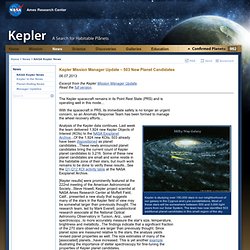
Read the full version. The Kepler spacecraft remains in its Point Rest State (PRS) and is operating well in this mode... With the spacecraft in PRS, its immediate safety is no longer an urgent concern, so an Anomaly Response Team has been formed to manage the wheel recovery efforts... Analysis of the Kepler data continues. [Kepler results] were prominently featured at the 222nd meeting of the American Astronomical Society...Steve Howell, Kepler project scientist at NASA Ames Research Center at Moffett Field, Calif., presented a new study that suggests many of the stars in the Kepler field of view may be somewhat larger than previously thought. Read the full update. Return to News Archive. Best map ever made of universe's oldest light: Planck mission brings universe into sharp focus. The Planck space mission has released the most accurate and detailed map ever made of the oldest light in the universe, revealing new information about its age, contents and origins.
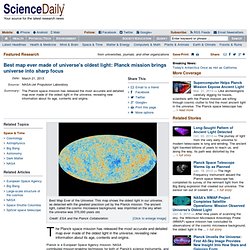
Planck is a European Space Agency mission. NASA contributed mission-enabling technology for both of Planck's science instruments, and U.S., European and Canadian scientists work together to analyze the Planck data. The map results suggest the universe is expanding more slowly than scientists thought, and is 13.8 billion years old, 100 million years older than previous estimates. The data also show there is less dark energy and more matter, both normal and dark matter, in the universe than previously known. Dark matter is an invisible substance that can only be seen through the effects of its gravity, while dark energy is pushing our universe apart. The age, contents and other fundamental traits of our universe are described in a simple model developed by scientists, called the standard model of cosmology. Wilkinson Microwave Anisotropy Probe (WMAP) Planck Mission Brings Universe Into Sharp Focus.
Cassini Solstice Mission. Radiolab - Space Episode. Take a facts-based journey through the universe. Astronomy for Kids Podcast. Celestron 21024 FirstScope Telescope: Camera & Photo. Peppercorn Earth Solar System. Copyright 1989 by Guy Ottewell Universal Workshop PO Box 102 Raynham, MA 02767-0102 Toll Free: 800-533-5083 Fax: 508-967-2702 Email: customerservice@universalworkshop.com This is a classic exercise for visualizing just how BIG our Solar System really is.
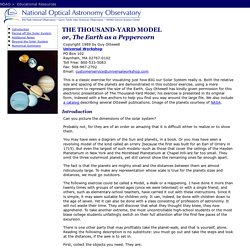
Both the relative size and spacing of the planets are demonstrated in this outdoor exercise, using a mere peppercorn to represent the size of the Earth. Guy Ottewell has kindly given permission for this electronic presentation of The Thousand-Yard Model; his exercise is presented in its original form, indexed with a few anchors to help you find you way around the large file.
We also include a catalog describing several Ottewell publications. Image of the planets courtesy of NASA. Introduction Can you picture the dimensions of the solar system? Probably not, for they are of an order so amazing that it is difficult either to realize or to show them. You may have seen a diagram of the Sun and planets, in a book. 10 paces. Another 9 paces. Rose City Astronomers. Lessons and Activities About Space, Astronomy, Planets, and the Solar System. Hands-On Astronomy Activities « Astronomical Society. The Extrasolar Planets Encyclopaedia — Diagrams. Google Sky. ©2017 Google - Terms of Use Image Credit: DSS Consortium, SDSS, NASA/ESA.
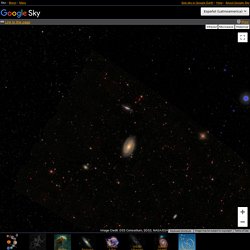
Sky Map for Android. What is Sky Map? Google Sky Map turns your Android-powered mobile phone into a window on the night sky. It will identify objects that appear in the sky and allow users to search for them. How can I get Sky Map? SKY-MAP.ORG. 1 Earth Year. Scale of Universe - Interactive Scale of the Universe Tool. The Scale of the Universe 2. The Biggest Stars In The Universe. The Known Universe by AMNH. Redshift - Sixty Symbols. 2014 Cosmos: A Space-Time Odyssey. Cosmos: A Spacetime Odyssey is a 2014 American science documentary television series.[1] The show is a follow-up to the 1980 television series Cosmos: A Personal Voyage, which was presented by Carl Sagan on the Public Broadcasting Service and is considered a milestone for scientific documentaries.

This series was developed to bring back the foundation of science to network television at the height of other scientific-based television series and films. The show is presented by astrophysicist Neil deGrasse Tyson, who, as a young college student, was inspired by Sagan. Among the executive producers are Seth MacFarlane, whose clout and financial investment were instrumental in bringing the show to broadcast television, and Ann Druyan, Sagan's widow and a co-creator of the original series.[2][3] The show is produced by Brannon Braga, and Alan Silvestri provides the backing score.[4] The series premiered on March 9, 2014,[5] simultaneously in the US across ten 21st Century Fox networks.
A Child's Introduction to the Night Sky. Bad Astronomy: Misconceptions and Misuses Revealed, from Astrology to the Moon Landing "Hoax": Philip C. Plait: 9780471409762: Amazon.com. Death by Black Hole: And Other Cosmic Quandaries: Neil deGrasse Tyson. 13 Planets (8 + 4 dwarf) NatGeoKids. Basher Books - Astronomy. Welcome to Astronomy!
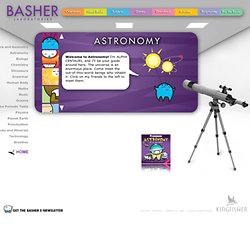
I’m ALPHA CENTAURI, and I’ll be your guide around here. The Everything Kids Astronomy Book.